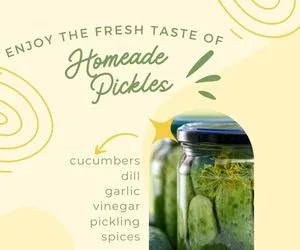
Are you ready to become a pickling pro? Look no further! In this comprehensive guide, we will take you through the step-by-step process of canning pickles like a true expert. Whether you’re a seasoned home cook or a complete novice in the kitchen, this guide is designed to equip you with all the knowledge and techniques you need to successfully preserve your favorite cucumbers and transform them into delicious pickles that will wow your family and friends.
From selecting the freshest cucumbers to mastering the perfect brine and achieving that irresistible crunch, we’ve got you covered. Get ready to dive into the world of pickling and discover the joy of creating your own homemade pickles bursting with flavor and goodness. Let’s roll up our sleeves and get pickling!
Before you get started on your pickling journey, it’s important to gather the essential equipment. Here’s a list of what you’ll need:
1. Canning jars: Choose jars that are specifically designed for canning to ensure proper sealing and preservation.
2. Lids and bands: These are necessary to create an airtight seal on the jars.
3. Canning pot: A large pot with a lid that can accommodate your canning jars and allow for proper processing.
4. Canning rack: This prevents the jars from coming into direct contact with the bottom of the pot, reducing the risk of breakage.
5. Jar lifter: A tool designed to safely lift hot jars in and out of the canning pot.
6. Funnel: This makes it easier to transfer the pickling liquid into the jars without any spills.
7. Kitchen towels: Essential for wiping the jar rims and ensuring a clean seal.
Having these items on hand will make your pickling process smooth and efficient.
When it comes to pickling cucumbers, not all varieties are created equal. The best cucumbers for pickling are firm and have a thin skin. English cucumbers, also known as seedless or burpless cucumbers, are a popular choice due to their uniform shape and minimal seeds. Kirby cucumbers, which are shorter and bumpier, are another excellent option. These cucumbers have a crisp texture and hold up well during the pickling process. Avoid using regular slicing cucumbers, as they tend to be watery and may result in mushy pickles. Once you’ve selected your cucumbers, give them a thorough wash to remove any dirt or debris.
Before you can start pickling, it’s important to properly prepare your cucumbers. Begin by trimming off both ends of the cucumbers, as they can contain enzymes that may lead to softening. Depending on your personal preference, you can leave the cucumbers whole or slice them into spears or chips. If you prefer a crisper pickle, consider soaking the cucumbers in an ice water bath for a couple of hours before pickling. This helps to remove any excess moisture and results in a crunchier texture. Once your cucumbers are prepped, it’s time to move on to the next step: creating the perfect pickling brine.
The pickling brine is a crucial component of any pickle recipe. It’s what gives the pickles their distinct tangy flavor and helps to preserve them. Here are two basic pickling brine recipes to get you started:
### Recipe 1: Classic Dill Pickles
– 4 cups water
– 2 cups distilled white vinegar
– 1/4 cup pickling salt
– 2 tablespoons sugar
– 4 cloves garlic, peeled and halved
– 2 teaspoons dill seeds
– 1 teaspoon black peppercorns
### Recipe 2: Sweet Bread and Butter Pickles
– 4 cups apple cider vinegar
– 2 cups granulated sugar
– 1/4 cup pickling salt
– 1 tablespoon mustard seeds
– 1 tablespoon celery seeds
– 1 teaspoon turmeric
– 1/2 teaspoon ground cloves
Feel free to adjust the seasonings and spices according to your taste preferences. Bring the brine ingredients to a boil in a saucepan, stirring until the sugar and salt have dissolved. Remove the brine from heat and let it cool while you prepare the additional ingredients for your pickles.
One of the joys of making your own pickles is the ability to customize the flavors. Here are some popular herbs, spices, and additional ingredients you can add to your pickles for an extra burst of flavor:
1. Dill: Fresh dill leaves or dill seeds add a classic dill flavor to your pickles.
2. Garlic: Cloves of garlic can be added whole, sliced, or minced to infuse the pickles with a delicious garlicky taste.
3. Peppercorns: Whole black or mixed peppercorns add a hint of spice to your pickles.
4. Red pepper flakes: For those who enjoy a bit of heat, red pepper flakes are a great addition.
5. Mustard seeds: These tiny seeds add a subtle tanginess to your pickles.
6. Celery seeds: Celery seeds contribute a unique flavor that pairs well with cucumbers.
7. Onion: Sliced onions can add sweetness and complexity to your pickles.
8. Jalapenos: For a spicy kick, add some sliced jalapenos to your pickling jars.
Feel free to experiment with different combinations to find your favorite flavor profile. Remember to add the herbs, spices, and additional ingredients to the jars before pouring in the brine.
Now that you have your cucumbers prepped and your brine ready, it’s time to start the pickling process. Follow these steps for pickling success:
1. Sterilize the canning jars: Place the jars in a large pot filled with water and bring it to a boil. Let the jars boil for 10 minutes to ensure they are properly sterilized. Remove the jars from the pot using a jar lifter and let them cool on a clean kitchen towel.
2. Pack the cucumbers into the jars: Place the prepared cucumbers into the sterilized jars, leaving a 1/2-inch headspace at the top.
3. Add the flavorings: Drop in your desired herbs, spices, and additional ingredients into each jar.
4. Pour in the pickling brine: Carefully ladle the prepared brine into each jar, leaving a 1/2-inch headspace.
5. Remove air bubbles: Gently tap the jars on the countertop to remove any air bubbles trapped inside.
6. Seal the jars: Wipe the jar rims with a clean kitchen towel to ensure a proper seal, then place the lids and bands on top. Tighten the bands until they are finger-tight.
7. Process the jars: Place the filled jars back into the canning pot, making sure they are submerged in water by at least an inch. Bring the water to a gentle boil and process the jars for the recommended time according to your recipe.
8. Remove the jars from the pot: Using a jar lifter, carefully lift the jars out of the pot and place them on a kitchen towel to cool.
9. Check the seals: After the jars have cooled for 12-24 hours, check the seals by pressing down on the center of each lid. If the lid doesn’t move or make a popping sound, the seal is secure.
10. Store the pickles: Label the jars with the date and store them in a cool, dark place for at least two weeks to allow the flavors to develop. Homemade pickles can be stored for up to a year.
To ensure the longevity of your homemade pickles, it’s important to store them properly. Keep the jars in a cool, dark place, such as a pantry or basement. Avoid storing them in direct sunlight or near heat sources, as this can cause the pickles to spoil. Once opened, refrigerate the pickles to maintain their freshness and crispness. Homemade pickles generally have a shelf life of up to a year if stored correctly.
Pickling can be a finicky process, and sometimes issues may arise. Here are some common problems and how to troubleshoot them:
1. Soft pickles: Soft pickles can be caused by using overripe or low-quality cucumbers. Ensure that you’re using firm cucumbers and follow the correct processing time and temperature.
2. Cloudy brine: Cloudy brine can be a result of using tap water that contains high levels of minerals. To prevent this, use distilled or filtered water.
3. Floaters: If you notice pickles floating in the jars, it could be due to not removing air bubbles during the packing process. Ensure that all air bubbles are released before sealing the jars.
4. Mold or yeast growth: Mold or yeast growth on the surface of the pickles is a sign of spoilage. Discard any jars that show signs of mold or yeast and thoroughly clean and sterilize your equipment before pickling again.
Once you’ve mastered the basics of pickling, you can explore advanced techniques and recipes to take your pickling skills to the next level. Some exciting options to consider include pickling different vegetables like carrots, onions, or green beans, experimenting with different types of vinegar, or trying out unique flavor combinations such as pickled watermelon rinds or spicy pickled peppers. The possibilities are endless, so don’t be afraid to get creative and have fun with your pickling experiments!
Congratulations! You’ve now reached the end of our comprehensive guide to canning pickles like a pro. Armed with the knowledge and techniques you’ve learned, you’re ready to embark on your pickling journey and create delicious homemade pickles that will impress everyone who tries them. Remember to start with fresh and high-quality cucumbers, gather the necessary equipment, and follow the step-by-step instructions for a successful pickling process. Don’t be afraid to experiment with flavors and ingredients to create your own signature pickles. With practice and a little bit of patience, you’ll soon become a pickling expert. Happy pickling!
